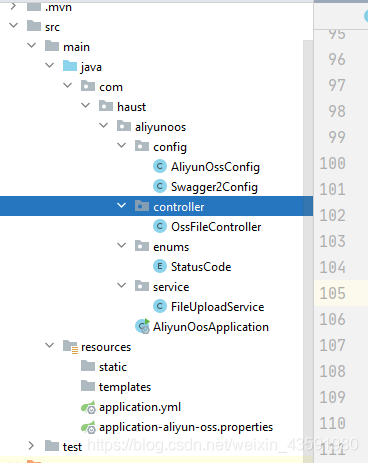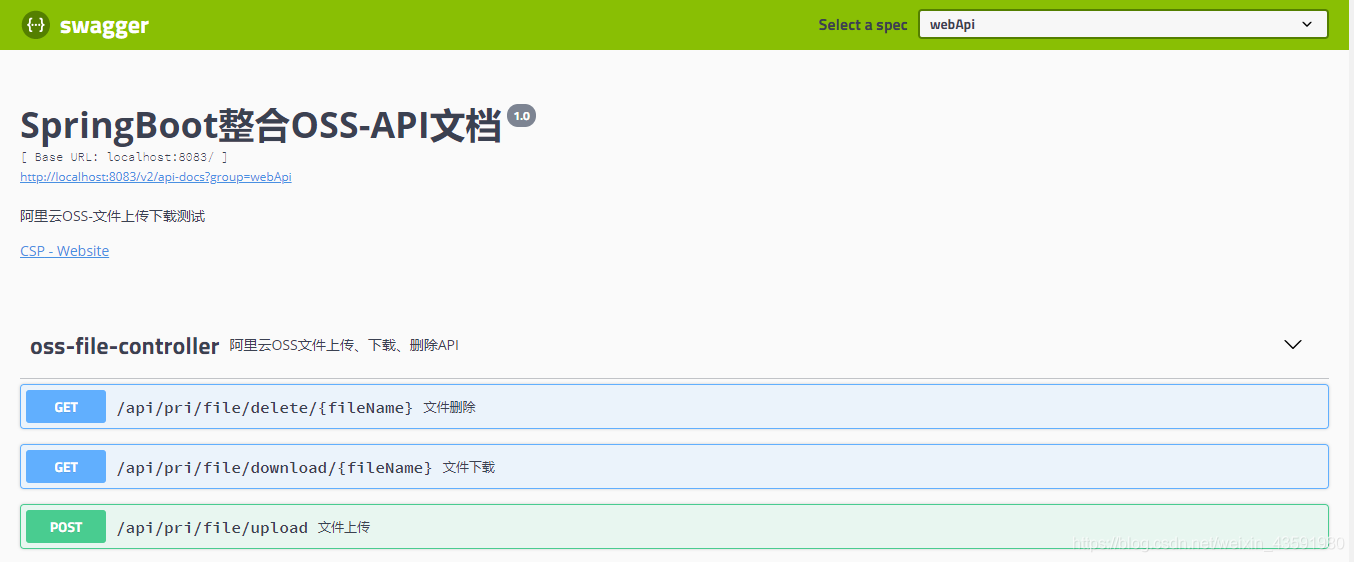这篇文章运用简单易懂的例子给大家介绍使用springboot操作阿里云OSS实现文件上传,下载,删除等功能,内容非常详细,感兴趣的小伙伴们可以参考借鉴,希望对大家能有所帮助。
创建一个spring boot项目,pom文件需要引入依赖:
pom.xml
<dependencies> <!-- 个人版本踩坑: 不加这个依赖的话,当在配置类中 使用@ConfigurationProperties(prefix = "aliyun")注解时, 我这个版本的spring boot会提示有问题 --> <dependency> <groupId>org.springframework.boot</groupId> <artifactId>spring-boot-configuration-processor</artifactId> <optional>true</optional> </dependency> <!-- swagger2 --> <dependency> <groupId>io.springfox</groupId> <artifactId>springfox-swagger2</artifactId> <version>2.9.2</version> </dependency> <!-- swagger ui --> <dependency> <groupId>io.springfox</groupId> <artifactId>springfox-swagger-ui</artifactId> <version>2.9.2</version> </dependency> <!-- thymeleaf 可不加,个人习惯性引入 --> <dependency> <groupId>org.springframework.boot</groupId> <artifactId>spring-boot-starter-thymeleaf</artifactId> </dependency> <!-- web --> <dependency> <groupId>org.springframework.boot</groupId> <artifactId>spring-boot-starter-web</artifactId> </dependency> <!-- 热部署,看个人习惯 --> <dependency> <groupId>org.springframework.boot</groupId> <artifactId>spring-boot-devtools</artifactId> <scope>runtime</scope> <optional>true</optional> </dependency> <!-- 小辣椒插件,推荐使用,可以节省javaBean的setter/getter,还可以使用链式调用 --> <dependency> <groupId>org.projectlombok</groupId> <artifactId>lombok</artifactId> <optional>true</optional> </dependency> <!-- fastJson --> <dependency> <groupId>com.alibaba</groupId> <artifactId>fastjson</artifactId> <version>1.2.62</version> </dependency> <!-- aliyun-oos --> <dependency> <groupId>com.aliyun.oss</groupId> <artifactId>aliyun-sdk-oss</artifactId> <version>2.8.3</version> </dependency> <dependency> <groupId>joda-time</groupId> <artifactId>joda-time</artifactId> <version>2.10.1</version> </dependency> <!-- apache-common-lang3 --> <dependency> <groupId>org.apache.commons</groupId> <artifactId>commons-lang3</artifactId> <version>3.8.1</version> </dependency> <dependency> <groupId>org.springframework.boot</groupId> <artifactId>spring-boot-starter-test</artifactId> <scope>test</scope> <exclusions> <exclusion> <groupId>org.junit.vintage</groupId> <artifactId>junit-vintage-engine</artifactId> </exclusion> </exclusions> </dependency> </dependencies>
包结构很简单:

我们使用自己添加的application-aliyun-oss.properties配置文件,去配置OSS相关信息,之所以不在application.yml 中配置,看个人习惯了,因为自定义的配置属性还是提出来配比较好,没必要所有的都配到application.yml(properties)中去。
application-aliyun-oss.properties
# 文件上传大小限制 spring.servlet.multipart.max-file-size=100MB spring.servlet.multipart.max-request-size=1000MB # 地域节点 aliyun.endPoint=oss-cn-beijing.aliyuncs.com # Bucket 域名 aliyun.urlPrefix=http://csp-xxxx.oss-cn-beijing.aliyuncs.com/ # accessKey Id aliyun.accessKeyId=LTAI4XXXXXXXzqD1saGFZ # accessKey Secret aliyun.accessKeySecret=2WjxNXXXXXXXX4f2bREc # 你的Bucket名称 aliyun.bucketName=csp-xxxx # 目标文件夹 aliyun.fileHost=files
config包下的相关配置类
AliyunOssConfig.java
/**
* @Auther: csp1999
* @Date: 2020/10/31/13:33
* @Description: 阿里云 OSS 基本配置
*/
// 声明配置类,放入Spring容器
@Configuration
// 指定配置文件位置
@PropertySource(value = {"classpath:application-aliyun-oss.properties"})
// 指定配置文件中自定义属性前缀
@ConfigurationProperties(prefix = "aliyun")
@Data// lombok
@Accessors(chain = true)// 开启链式调用
public class AliyunOssConfig {
private String endPoint;// 地域节点
private String accessKeyId;
private String accessKeySecret;
private String bucketName;// OSS的Bucket名称
private String urlPrefix;// Bucket 域名
private String fileHost;// 目标文件夹
// 将OSS 客户端交给Spring容器托管
@Bean
public OSS OSSClient() {
return new OSSClient(endPoint, accessKeyId, accessKeySecret);
}
}Swagger2Config.java
/**
* @Auther: csp1999
* @Date: 2020/10/31/16:30
* @Description: Swagger 配置类
*/
@Configuration
@EnableSwagger2// 开启swagger2
public class Swagger2Config {
@Bean
public Docket webApiConfig() {
return new Docket(DocumentationType.SWAGGER_2)
.groupName("webApi")
.apiInfo(webApiInfo())
.select()
.paths(Predicates.not(PathSelectors.regex("/error.*")))
.build();
}
private ApiInfo webApiInfo() {
return new ApiInfoBuilder()
.title("SpringBoot整合OSS-API文档")
.description("阿里云OSS-文件上传下载测试")
.version("1.0")
.contact(new Contact("CSP", "https://blog.csdn.net/weixin_43591980", ""))
.build();
}
}定义一个关于执行状态结果的枚举类
/**
* @Auther: csp1999
* @Date: 2020/10/31/17:03
* @Description: 状态码枚举类
*/
public enum StatusCode {
SUCCESS("success",200),ERROR("error",500);
private String msg;
private Integer code;
StatusCode(String msg,Integer code){
this.msg = msg;
this.code = code;
}
StatusCode(Integer code){
this.code = code;
}
StatusCode(String msg){
this.msg = msg;
}
public String getMsg() {
return msg;
}
public void setMsg(String msg) {
this.msg = msg;
}
public Integer getCode() {
return code;
}
public void setCode(Integer code) {
this.code = code;
}
}service层
在service使用ossClient操作阿里云OSS,进行上传、下载、删除、查看所有文件等操作,同时可以将图片的url进行入库操作:
FileUploadService.java
/**
* @Auther: csp1999
* @Date: 2020/10/31/14:30
* @Description: 文件上传Service (为节省文章中的代码篇幅,不再做接口实现类处理)
*/
@Service("fileUploadService")
public class FileUploadService {
// 允许上传文件(图片)的格式
private static final String[] IMAGE_TYPE = new String[]{".bmp", ".jpg",
".jpeg", ".gif", ".png"};
@Autowired
private OSS ossClient;// 注入阿里云oss文件服务器客户端
@Autowired
private AliyunOssConfig aliyunOssConfig;// 注入阿里云OSS基本配置类
/*
* 文件上传
* 注:阿里云OSS文件上传官方文档链接:https://help.aliyun.com/document_detail/84781.html?spm=a2c4g.11186623.6.749.11987a7dRYVSzn
* @param: uploadFile
* @return: string
* @create: 2020/10/31 14:36
* @author: csp1999
*/
public String upload(MultipartFile uploadFile) {
// 获取oss的Bucket名称
String bucketName = aliyunOssConfig.getBucketName();
// 获取oss的地域节点
String endpoint = aliyunOssConfig.getEndPoint();
// 获取oss的AccessKeySecret
String accessKeySecret = aliyunOssConfig.getAccessKeySecret();
// 获取oss的AccessKeyId
String accessKeyId = aliyunOssConfig.getAccessKeyId();
// 获取oss目标文件夹
String filehost = aliyunOssConfig.getFileHost();
// 返回图片上传后返回的url
String returnImgeUrl = "";
// 校验图片格式
boolean isLegal = false;
for (String type : IMAGE_TYPE) {
if (StringUtils.endsWithIgnoreCase(uploadFile.getOriginalFilename(), type)) {
isLegal = true;
break;
}
}
if (!isLegal) {// 如果图片格式不合法
return StatusCode.ERROR.getMsg();
}
// 获取文件原名称
String originalFilename = uploadFile.getOriginalFilename();
// 获取文件类型
String fileType = originalFilename.substring(originalFilename.lastIndexOf("."));
// 新文件名称
String newFileName = UUID.randomUUID().toString() + fileType;
// 构建日期路径, 例如:OSS目标文件夹/2020/10/31/文件名
String filePath = new SimpleDateFormat("yyyy/MM/dd").format(new Date());
// 文件上传的路径地址
String uploadImgeUrl = filehost + "/" + filePath + "/" + newFileName;
// 获取文件输入流
InputStream inputStream = null;
try {
inputStream = uploadFile.getInputStream();
} catch (IOException e) {
e.printStackTrace();
}
/**
* 下面两行代码是重点坑:
* 现在阿里云OSS 默认图片上传ContentType是image/jpeg
* 也就是说,获取图片链接后,图片是下载链接,而并非在线浏览链接,
* 因此,这里在上传的时候要解决ContentType的问题,将其改为image/jpg
*/
ObjectMetadata meta = new ObjectMetadata();
meta.setContentType("image/jpg");
//文件上传至阿里云OSS
ossClient.putObject(bucketName, uploadImgeUrl, inputStream, meta);
/**
* 注意:在实际项目中,文件上传成功后,数据库中存储文件地址
*/
// 获取文件上传后的图片返回地址
returnImgeUrl = "http://" + bucketName + "." + endpoint + "/" + uploadImgeUrl;
return returnImgeUrl;
}
/*
* 文件下载
* @param: fileName
* @param: outputStream
* @return: void
* @create: 2020/10/31 16:19
* @author: csp1999
*/
public String download(String fileName, HttpServletResponse response) throws UnsupportedEncodingException {
// // 设置响应头为下载
// response.setContentType("application/x-download");
// // 设置下载的文件名
// response.addHeader("Content-Disposition", "attachment;fileName=" + fileName);
// response.setCharacterEncoding("UTF-8");
// 文件名以附件的形式下载
response.setHeader("Content-Disposition", "attachment;filename=" + URLEncoder.encode(fileName, "UTF-8"));
// 获取oss的Bucket名称
String bucketName = aliyunOssConfig.getBucketName();
// 获取oss目标文件夹
String filehost = aliyunOssConfig.getFileHost();
// 日期目录
// 注意,这里虽然写成这种固定获取日期目录的形式,逻辑上确实存在问题,但是实际上,filePath的日期目录应该是从数据库查询的
String filePath = new DateTime().toString("yyyy/MM/dd");
String fileKey = filehost + "/" + filePath + "/" + fileName;
// ossObject包含文件所在的存储空间名称、文件名称、文件元信息以及一个输入流。
OSSObject ossObject = ossClient.getObject(bucketName, fileKey);
try {
// 读取文件内容。
InputStream inputStream = ossObject.getObjectContent();
BufferedInputStream in = new BufferedInputStream(inputStream);// 把输入流放入缓存流
ServletOutputStream outputStream = response.getOutputStream();
BufferedOutputStream out = new BufferedOutputStream(outputStream);// 把输出流放入缓存流
byte[] buffer = new byte[1024];
int len = 0;
while ((len = in.read(buffer)) != -1) {
out.write(buffer, 0, len);
}
if (out != null) {
out.flush();
out.close();
}
if (in != null) {
in.close();
}
return StatusCode.SUCCESS.getMsg();
} catch (Exception e) {
return StatusCode.ERROR.getMsg();
}
}
/*
* 文件删除
* @param: objectName
* @return: java.lang.String
* @create: 2020/10/31 16:50
* @author: csp1999
*/
public String delete(String fileName) {
// 获取oss的Bucket名称
String bucketName = aliyunOssConfig.getBucketName();
// 获取oss的地域节点
String endpoint = aliyunOssConfig.getEndPoint();
// 获取oss的AccessKeySecret
String accessKeySecret = aliyunOssConfig.getAccessKeySecret();
// 获取oss的AccessKeyId
String accessKeyId = aliyunOssConfig.getAccessKeyId();
// 获取oss目标文件夹
String filehost = aliyunOssConfig.getFileHost();
// 日期目录
// 注意,这里虽然写成这种固定获取日期目录的形式,逻辑上确实存在问题,但是实际上,filePath的日期目录应该是从数据库查询的
String filePath = new DateTime().toString("yyyy/MM/dd");
try {
/**
* 注意:在实际项目中,不需要删除OSS文件服务器中的文件,
* 只需要删除数据库存储的文件路径即可!
*/
// 建议在方法中创建OSSClient 而不是使用@Bean注入,不然容易出现Connection pool shut down
OSSClient ossClient = new OSSClient(endpoint,
accessKeyId, accessKeySecret);
// 根据BucketName,filetName删除文件
// 删除目录中的文件,如果是最后一个文件fileoath目录会被删除。
String fileKey = filehost + "/" + filePath + "/" + fileName;
ossClient.deleteObject(bucketName, fileKey);
try {
} finally {
ossClient.shutdown();
}
System.out.println("文件删除!");
return StatusCode.SUCCESS.getMsg();
} catch (Exception e) {
e.printStackTrace();
return StatusCode.ERROR.getMsg();
}
}
}controller层
controller提供测试接口
/**
* @Auther: csp1999
* @Date: 2020/10/31/16:40
* @Description: OSS 文件上传controller
*/
@Api(description = "阿里云OSS文件上传、下载、删除API")
@RequestMapping("api/pri/file")
@RestController
public class OssFileController {
@Autowired
private FileUploadService fileUploadService;
/*
* 文件上传api
* @param: file
* @return: com.alibaba.fastjson.JSONObject
* @create: 2020/10/31 17:35
* @author: csp1999
*/
@ApiOperation(value = "文件上传")
@PostMapping("upload")
public JSONObject upload(@RequestParam("file") MultipartFile file) {
JSONObject jsonObject = new JSONObject();
if (file != null) {
String returnFileUrl = fileUploadService.upload(file);
if (returnFileUrl.equals("error")) {
jsonObject.put("error", "文件上传失败!");
return jsonObject;
}
jsonObject.put("success", "文件上传成功!");
jsonObject.put("returnFileUrl", returnFileUrl);
return jsonObject;
} else {
jsonObject.put("error", "文件上传失败!");
return jsonObject;
}
}
/*
* 文件下载api
* @param: fileName
* @param: response
* @return: com.alibaba.fastjson.JSONObject
* @create: 2020/10/31 17:35
* @author: csp1999
*/
@ApiOperation(value = "文件下载")
@GetMapping(value = "download/{fileName}")
public JSONObject download(@PathVariable("fileName") String fileName, HttpServletResponse response) throws Exception {
JSONObject jsonObject = new JSONObject();
String status = fileUploadService.download(fileName, response);
if (status.equals("error")) {
jsonObject.put("error", "文件下载失败!");
return jsonObject;
} else {
jsonObject.put("success", "文件下载成功!");
return jsonObject;
}
}
/*
* 文件删除api
* @param: fileName
* @return: com.alibaba.fastjson.JSONObject
* @create: 2020/10/31 17:35
* @author: csp1999
*/
@ApiOperation(value = "文件删除")
@GetMapping("/delete/{fileName}")
public JSONObject DeleteFile(@PathVariable("fileName") String fileName) {
JSONObject jsonObject = new JSONObject();
String status = fileUploadService.delete(fileName);
if (status.equals("error")) {
jsonObject.put("error", "文件删除失败!");
return jsonObject;
} else {
jsonObject.put("success", "文件删除成功!");
return jsonObject;
}
}
}本机访问:http://localhost:8083/swagger-ui.html

测试上传:

结果如图:

如果说明上传成功,我们来看一下这个链接能不能访问到:


关于使用springboot操作阿里云OSS实现文件上传,下载,删除等功能就分享到这里了,希望以上内容可以对大家有一定的帮助,可以学到更多知识。如果觉得文章不错,可以把它分享出去让更多的人看到。
免责声明:本站发布的内容(图片、视频和文字)以原创、转载和分享为主,文章观点不代表本网站立场,如果涉及侵权请联系站长邮箱:is@yisu.com进行举报,并提供相关证据,一经查实,将立刻删除涉嫌侵权内容。